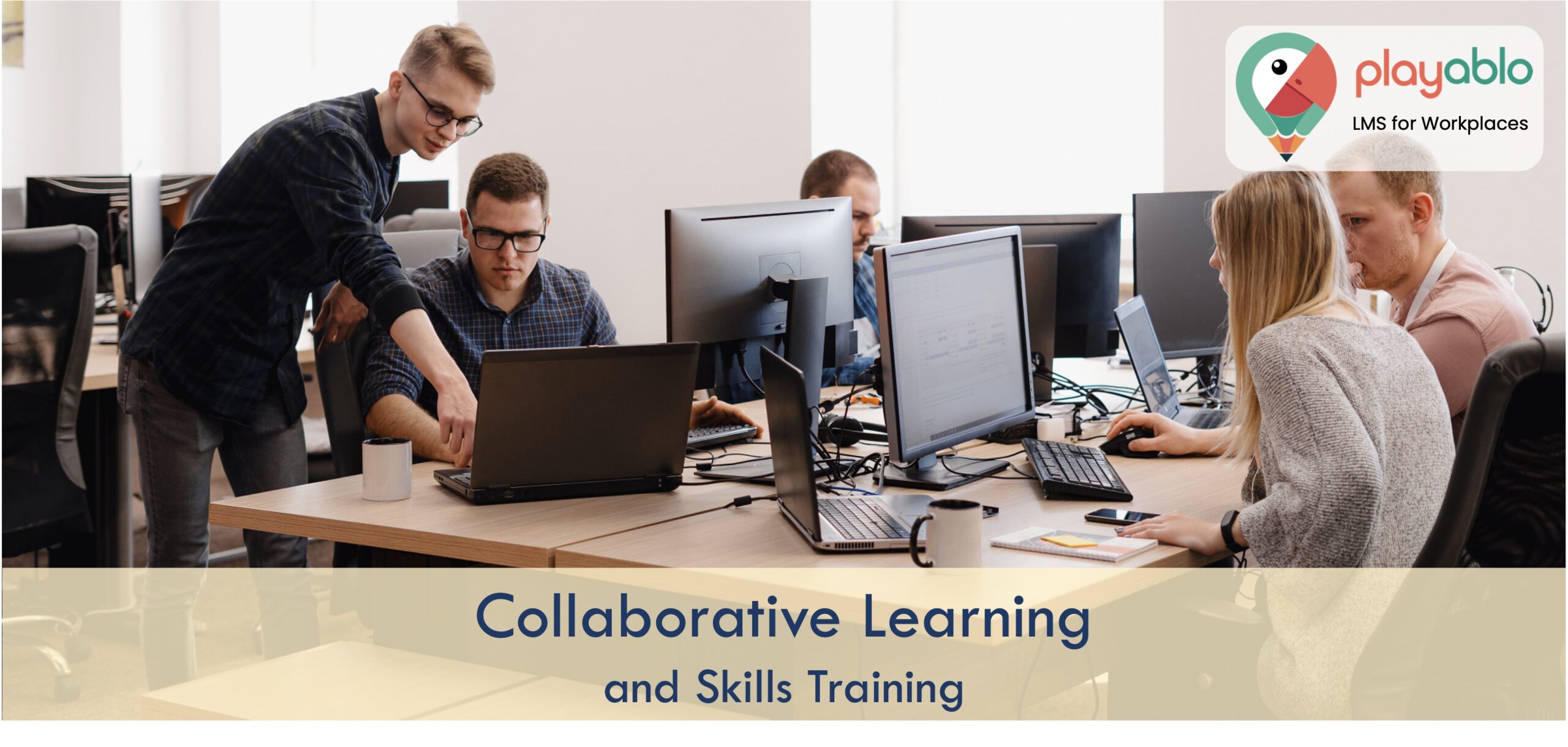This blog will explain the importance of collaborative skills in the workplace. It will also discuss the nine major types of collaborative training. We will then discuss how you can use eLearning to boost collaborative skills in your firm.
Over the decades, corporate training methodologies have seen a significant transformation. However, the departure from the conventional instructor-led and text-heavy document-based learning paradigms may be the most substantial shift.
Institutional knowledge is viewed as an organization’s most extensive resource in the 21st-century workplace. Collaborative skills training serves as a novel method of instruction and information-sharing in the workplace due to institutional knowledge.
The goal of collaborative skills training programs is to maximize education and participation by allowing staff members to support each other all through the learning experience. These programs go beyond formal team training.
Table of Contents
Collaborative skills training: What is it?

Employees can share their experience and knowledge while simultaneously learning from and instructing one another through the collaborative learning algorithm. By utilizing individual talents, expertise, and insights, this strategy enhances the complete learning experience for participants.
By paying attention to various points of view, rephrasing concepts, and clearly explaining their arguments, employees come to a deeper understanding as a team than they achieve as individuals. Because of this, collaborative skills training is a valuable method for training activities.
Ad: PlayAblo’s Enterprise-Grade Micro-Learning platform is built for millennial learners. Micro-Learning and assessments and gamification features ensure learning outcome measurement and sustained engagement.
Find out more and request a custom demo!
Advantages of collaborative skills training in the workplace
Fosters a culture of learning
By fostering an environment where employees regularly collaborate, share knowledge, and benefit from each other, workplace collaborative skills training aids in developing a common learning culture.
Expands staff skills and knowledge
Employees that participate in collaborative skills training get various knowledge and competencies. Mentoring others will further develop their abilities and help them pick up new ones from their coworkers. Therefore, sharing and receiving knowledge is a part of collaborative skills training. This lessens the requirement for formal education while promoting ongoing skill development among personnel.
Increases memory retention

The Ebbinghaus forgetting curve states that humans typically forget 50% of freshly learned information within a few weeks or even days. An answer to this problem is collaborative skills training.
Studies have shown that engaging through active learning improves memory. Employees who take peer-generated classes learn more actively because they can participate in the study materials, pose questions, or offer suggestions. Because information is supported by solid reasoning inside a collaborative learning environment, knowledge retention is improved.
Enhances teamwork
Promoting relationships and cooperation becomes challenging in a remote work situation. Individuals can uncover new ties and methods to perform together by playing to one another’s strengths by participating in collaborative skills training.
Increases employee retention and engagement
By improving employee involvement and peer instruction, which is otherwise rarely achievable, collaborative learning benefits professional development. A healthy workplace, a supportive work environment, and higher employee satisfaction contribute to long-term staff retention when individuals learn and collaborate.
9 types of collaborative skills training at the workplace

Cooperative learning environments
Collaborative learning communities are a setting that encourages teamwork to solve issues and accomplish new goals. It places a high value on open dialogue and provides people with the chance to both benefit from and educate others.
Below are some illustrations of how to create a prosperous community:
- Develop a community of learners with the goal-based action plan that you desire to see realized in mind.
- Encourage community interaction and dialogue.
- Select a representative to serve as the community’s voice. A facilitator makes sure that the objectives are achieved in a manner that is appropriate for the team’s learning environment.
- Each person has unique learning preferences, strengths, and shortcomings. The learning community should be aware of its group dynamics, modify its techniques to account for the diverse groupmates, and ensure that everyone works together and draws on one another’s ideas.
Groups coaching groups
By having several teams or divisions train other teams on their duties, you can implement collaborative skills training tactics in your work procedures in a straightforward yet efficient approach.
During these discussions, teams can discuss their observations and responsibilities with the entire organization and offer suggestions for addressing problems that could fall under their purview.
Peer education
Peer learning comprises more than two coworkers seeking and sharing knowledge while learning together. Professionals generate learning materials for their coworkers as part of peer collaborative skills training. This is one of the finest methods to encourage employees to communicate their expertise, as it frees L&D departments from the ongoing creation and upgrading of staff training materials.
You can implement Peer learning in the following ways:

- Assemble new hires with an “orientation and training buddy,” a colleague with greater expertise. New hires can fit into the business more quickly if they have a coach to aid them.
- Create online task forces that permit employees to form cooperative teams.
- Brown bag and “learn at lunch” sessions are prevalent peer training practices where employees learn new material and engage with their colleagues in a casual, social setting.
Peer reviews
Among the most significant ways to conduct a performance evaluation is to implement a peer review system where workers receive feedback from their coworkers.
Employees can examine and be motivated by one another’s performance through peer reviews, which promote two-way learning. Workers gain a lot when they receive feedback from sources apart from their supervisor, and it also gives them the confidence to speak up without holding back.
Here are some tips for conducting peer reviews successfully:
- Managers choose peers for the workforce’s peer evaluation procedure.
- Managers inform their staff about the goal of the peer performance assessment. Peer reviews are intended to help workers support one another and develop into their best professional selves.
- Utilizing software and an intranet that optimizes the evaluation process while obtaining crucial data and employee feedback might improve peer-to-peer performance evaluation processes.
- To supplement the numerical scales, permit employees to give their own personal judgments.
- Managers engage personally with the workers assessed as per peer reviews to go over the input.
Online working
Virtual coworking encourages cooperation by enabling distant teams working in various time zones to share ideas and information, feel a part of their company, and be more effective.
Here’s how to put virtual coworking into practice:
- Use online collaboration platforms to control communication channels and cooperation.
- HR managers and teams must arrange frequent online one-on-one sessions with their staff to ensure there aren’t any issues.
- Invest in tools for knowledge management to make it easier for distant workers to share expertise.
- Design a clear career trajectory with quantifiable monthly targets to offer each worker a sense of purpose and foster an ownership culture.
- Conduct online workshops for skills training to allow distant workers to interact, learn from, and operate together.
- Establish scheduled coworking events so workers can concentrate on their separate projects while still being with one another.
Ad: PlayAblo’s Enterprise-Grade Micro-Learning platform is built for millennial learners. Micro-Learning and assessments and gamification features ensure learning outcome measurement and sustained engagement.
Find out more and request a custom demo!
Jigsaw technique

A collaborative skills training strategy known as the “jigsaw technique” divides organizations and tasks among small teams of employees. Each group member is given a particular subtopic to concentrate on. They mentor their colleagues on the procedure when they become experts in a specific component of the jigsaw and comprehend how it integrates into the team’s jigsaw.
Because one worker is dependent upon the other to complete the puzzle, this strategy is particularly effective in encouraging teamwork and the notion of team performance among employees.
How to use the Jigsaw method is as follows:
- Divide the team’s members into 5–6-person groups.
- Give each group a particular task for the project.
- Assign a deadline for each group member to complete their research on their chosen topic.
- Hold a group gathering after the allotted period so each individual can impart their knowledge and instruct other group members.
Think-pair-share
Think-pair-share encourages immediate teamwork and experiential learning among partners, among the most popular and low-effort collaborative skills training methodologies.
The think-pair-share method entails three parts, as its name suggests: thinking (brainstorming on a subject), pairing (forming employee teams), and sharing (teams sharing their insights). The think-pair-share method encourages workers to think analytically and provides workplace discussions with a defined format.
How to use think-pair-share?
- A supervisor or team leader selects the concerns or issues in the initial step. Employees are granted a short amount of time to reflect on the assigned subject.
- In the next step, teams of two to three individuals are paired together to exchange ideas.
- Employees communicate their responses and gain knowledge as a team during the third step, which is extended to group discussions.
Teamwork to solve issues

A bunch of learners is assigned a particular issue to address over a predetermined time in team problem-solving, a sort of collaborative skills training. This method encourages learners to strive for a deeper comprehension of ideas while enhancing teamwork and communication.
Here’s how to put collaborative problem-solving into practice:
- Find the issue a unit is having and its root cause.
- Pick a supervisor to facilitate the team’s problem-solving process.
- The team’s manager provides a general description of the desired outcomes.
- So that the community has a wide range of possibilities for potential solutions, each person brainstorms solutions or ideas.
- Employees show their work at the conclusion, defend their decisions, and outline their strategies for implementing the solution.
eLearning
Online collaborative learning is among the best methods to increase user engagement and support cognitive learning. It enables business trainees to talk about their experiences, which most frequently aids in their deeper understanding of the principles. eLearning will greatly benefit employees and significantly raise their performance and output at the workplace. Online collaboration additionally adds pleasure and enjoyment to virtual training sessions. This approach increases their motivation and involvement as a result. Here are six original strategies for fostering teamwork in eLearning courses.
Social media showcase
The majority of people use the internet. Social media interaction should be considered if you want to make your online courses as interactive as feasible. Users use Instagram, Facebook, and Twitter to talk and read the most recent news. Peer engagement is made possible through LMS platforms which incorporate social media usage.
Users can use social media icons to converse about various subjects and exchange advice on making the most of their online training.
Utilizing online training programs to boost efficiency and competencies is not the only way to learn effectively. Additionally, it entails gathering and dispersing eLearning comments. For this, digital networks are a fantastic platform. Trainees can utilize social media to improve their colleagues’ eLearning experiences and provide feedback.
Request feedback from corporate learners after asking them to publish their own elearning materials. Furthermore, to recognize opportunities for improvement and highlight strengths, social media display enables them to increase their own expertise by leveraging elearning resources generated by other professional learners.
Convert staff members into bloggers

Another successful strategy for fostering teamwork is blogging. Corporate learners could communicate freely and openly thanks to blog posts. A worker may decide to write about a particular online course module after finishing it. As a result, your firm will receive insightful eLearning reviews and more relevant online training experiences.
They can publish a blog entry to illustrate how they overcame obstacles at work through a specific online training course. Because blogs frequently allow comment sections, blogging transforms your company’s LMS into a community-based online training resource.
Corporate eLearning blogs allow for comments from other users, enabling them to share their feelings and thoughts constructively. The teamwork that results from this idea sharing makes the best use of the eLearning resources for business learners.
Design projects for group collaboration
Create group collaboration assignments that ask learners to cooperate to achieve the task or resolve an issue. When it pertains to overcoming problems, people typically follow different paths. Having them work together on a task exposes students to various perspectives, which fosters more efficient learning.
Learners gain experience and knowledge from one another. This approach encourages the growth of skills, content mastery, and recollection. Offer a genuine puzzle to solve, rather than just a lesson, to keep things interesting. For instance, they must work together to address a typical compliance problem and devise several solutions.
Include scenarios with team-based branching

Employees should be asked to utilize their abilities to solve issues and obstacles as part of virtual training programs to gauge their qualitative knowledge. Learners can discover how to put their new skills to address real-world problems by including real-world situations in their digital training programs.
Additionally, branching scenarios produce emotionally compelling experiences that let corporate learners relate to the concepts in reality. It does not need to be a solitary activity, though.
You can turn them into collaborative activities that include debates, discussions, or healthy competition to promote collaboration via eLearning courses. Give learners a brief rundown of the upcoming task. After that, request that they deliberate over each option before deciding.
For example, they should discuss all the alternatives and solutions offered and justify their decision to take a particular course. They can use this to test their assumptions and views and understand many points of view.
Hold live online training sessions
As long as employees have a steady internet connection, learners can access eLearning resources from anywhere. This enables a live digital training session involving trainees and allows them to communicate with distant colleagues.
The participants might debate a particular training theme or the subjects covered in an eLearning session. Even better, split them into teams and ask each group to organize its own live web training session. They must draft a plan and produce supplemental online training materials or exercises for their virtual peers.
Organize regular online debates
Since the backgrounds of your learners vary, there may occasionally be disagreements. Organize a weekly forum on social networks or digitally where participants can examine their points of view and interact with others. The hitch is that they have to remain polite and on the subject.
Learners can summarize the discussion and emphasize what they learned at the conclusion of it. Which of your own personal presumptions or opinions, for instance, were disproved during the online live training session?
Conclusion
Collaboration is crucial for successful online learning. It aids corporate learners in better comprehending the ideas offered in the eLearning courses and in utilizing the opportunities for social learning. Use these six suggestions to promote teamwork via eLearning courses and to produce more captivating and memorable peer-to-peer training experiences.
Ad: PlayAblo’s Enterprise-Grade Micro-Learning platform is built for millennial learners. Micro-Learning and assessments and gamification features ensure learning outcome measurement and sustained engagement.
Find out more and request a custom demo!







Comments are closed, but trackbacks and pingbacks are open.